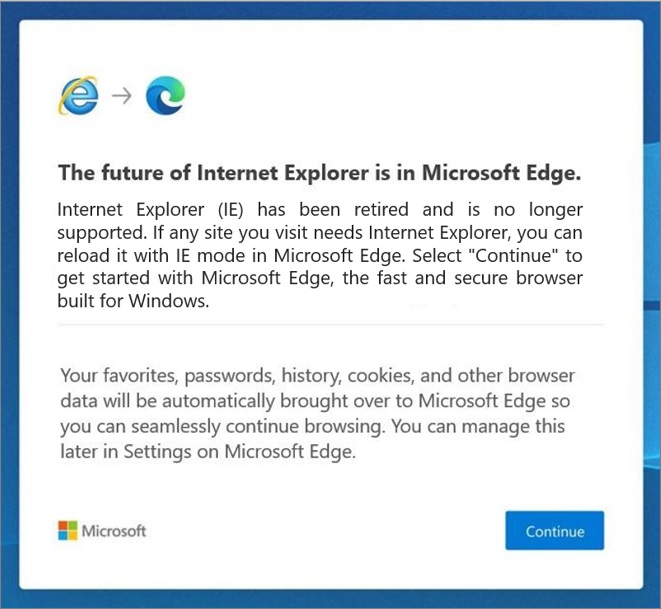Microsoft is finally saying goodbye to Internet Explorer – a browser whose primary purpose, in recent years at least, was downloading a different browser on a fresh Windows install.
As of today, official support for Internet Explorer has finished, leaving Microsoft with the task of gradually nudging its customers over to the Edge browser before it pulls the plug on for good.
For the time being, Internet Explorer will still appear in your taskbar, but when you open it, a tab will load a page recommending you make Edge your default browser instead.
Over the coming months, said Sean Lyndersay, general manager of Microsoft Edge Enterprise, clicking the Internet Explorer icon will instead open Edge.
Then, with one final Windows update, the old browser will be soon be permanently removed from devices.
“Incremental improvements to Internet Explorer couldn’t match the general improvements to the web at large, so we started fresh,” Lyndersay said in a blog post.
“Microsoft Edge is a faster, more secure and modern browser – the best browser for Windows – designed for today’s internet.”
Edge is based on Google’s open-source Chromium project which means many Chrome extensions and APIs are cross-compatible.
Microsoft is hoping Edge will see it once again hold a decent share of the browser market which has been dominated by Chrome and Safari since around 2014.
According to Statcounter, around 60 per cent of Australians used Internet Explorer as their primary browser in early 2009, with Firefox coming in second place.
But Microsoft’s default browser couldn’t keep up with the pace of Chrome and iOS default browser Safari, resulting in a gradual decline in use before Microsoft decided to put the browser outs of its misery.

An example of the redirect Internet Explorer users will see. Image: supplied
Internet Explorer has had a long and fraught history which began with licensing code from early web browser Mosaic, built by Spyglass Inc.
The deal meant Microsoft had to pay Spyglass royalties for each distributed copy of Internet Explorer, which had been shipped alongside a version of Windows 95 and Windows NT.
Spyglass took Microsoft to court, saying it had stiffed it out of royalties before reaching a US$8 million settlement in 1997.
As that settlement was being reached, Microsoft was preparing to dominate the browser market with the release of Internet Explorer 4 which it integrated into its dominant desktop operating system, Windows.
By including Internet Explorer for free and by default, Microsoft positioned its browser to become the world’s most used in an attempt to “smother” its rival Netscape Navigator.
The battle for browser dominance was a contributor in an antitrust case against Microsoft in the early 2000s which included Microsoft trying to prove that Internet Explorer was so vital to Windows that the OS would significantly slow down if it were removed.










